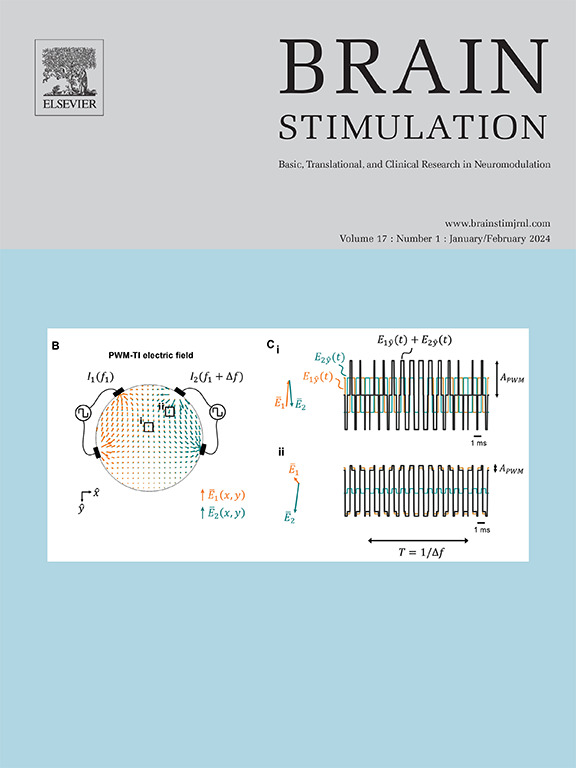tDCS cranial nerve Co-stimulation: Unveiling brainstem pathways involved in trigeminal nerve direct current stimulation in rats
IF 7.6
1区 医学
Q1 CLINICAL NEUROLOGY
引用次数: 0
Abstract
Background
The effects of transcranial direct current stimulation (tDCS) are generally thought to result from the polarization of cortical neurons by the weak electric fields it creates. However, recent evidence suggests that some tDCS effects may be mediated through co-stimulation of peripheral or cranial nerves, particularly the trigeminal nerve (TN). The TN projects to key brainstem nuclei that regulate neurotransmitter release throughout the central nervous system, but the specific pathways involved are not yet well understood.
Methods
In this study, we examined the effects of acute transcutaneous TN direct current stimulation (TN-DCS) on tonic (i.e. mean spike rate) and phasic (number of bursts, spike rate per burst, burst duration, and inter-burst interval) activities while simultaneously recording single-neuron activity across three brainstem nuclei in rats: the locus coeruleus (LC; phasic and tonic activities), dorsal raphe nucleus (DRN; tonic activity), and median raphe nucleus (MnRN; tonic activity).
Results
TN-DCS significantly modulated tonic activity in the LC and DRN, with interactions between amplitude, polarity, and time affecting mean spike rates. It also influenced phasic activity in the LC, altering burst number, duration, and inter-burst intervals. In contrast, MnRN tonic activity was unchanged. Blocking TN with xylocaine eliminated the effects on tonic activity in both the LC and DRN.
Conclusions
These results suggest that tDCS may modulate the TN, altering DRN and LC activity. Differential changes in tonic and phasic LC activity highlight their roles in TN-DCS effects on the cortex. This research offers insights to improve tDCS efficacy and understanding. Keywords: tDCS; trigeminal nerve; locus coeruleus; Dorsal raphe nucleus; median raphe nucleus.
tDCS颅神经共刺激:揭示大鼠三叉神经直流电刺激参与的脑干通路。
背景:经颅直流电刺激(tDCS)的作用通常被认为是由于其产生的弱电场使皮质神经元极化所致。然而,最近的证据表明,一些tDCS效应可能是通过外周神经或颅神经,特别是三叉神经(TN)的共同刺激来介导的。TN投射到调节整个中枢神经系统神经递质释放的关键脑干核,但涉及的具体途径尚不清楚。方法:在这项研究中,我们检测了急性经皮TN直流电刺激(TN- dcs)对大鼠脑干三个核的单神经元活动的影响,同时记录了大鼠脑干三个核的单神经元活动:蓝斑核(LC;中缝背核(DRN;中缝正中核(MnRN;主音活动)。结果:n - dcs显著调节LC和DRN的张力活动,振幅、极性和时间之间的相互作用影响平均峰值速率。它还影响了LC的相活动,改变了爆发次数、持续时间和爆发间隔。相比之下,MnRN强直活动没有变化。用木卡因阻断TN消除了LC和DRN对强直活性的影响。结论:tDCS可调节TN,改变DRN和LC活性。强直和相位LC活动的差异变化突出了它们在TN-DCS对皮层的影响中的作用。本研究为提高tDCS的疗效和理解提供了新的见解。
本文章由计算机程序翻译,如有差异,请以英文原文为准。
求助全文
约1分钟内获得全文
求助全文
来源期刊

Brain Stimulation
医学-临床神经学
CiteScore
13.10
自引率
9.10%
发文量
256
审稿时长
72 days
期刊介绍:
Brain Stimulation publishes on the entire field of brain stimulation, including noninvasive and invasive techniques and technologies that alter brain function through the use of electrical, magnetic, radiowave, or focally targeted pharmacologic stimulation.
Brain Stimulation aims to be the premier journal for publication of original research in the field of neuromodulation. The journal includes: a) Original articles; b) Short Communications; c) Invited and original reviews; d) Technology and methodological perspectives (reviews of new devices, description of new methods, etc.); and e) Letters to the Editor. Special issues of the journal will be considered based on scientific merit.
 求助内容:
求助内容: 应助结果提醒方式:
应助结果提醒方式:


